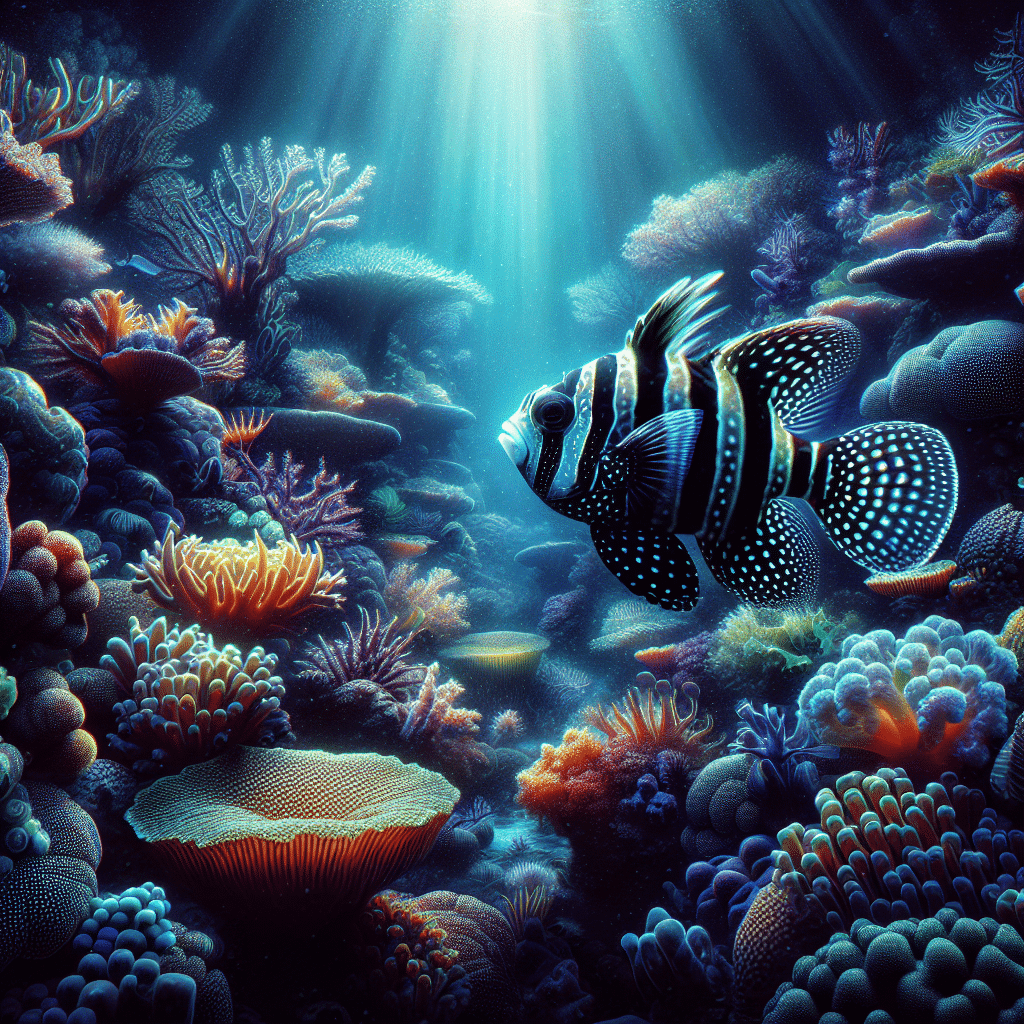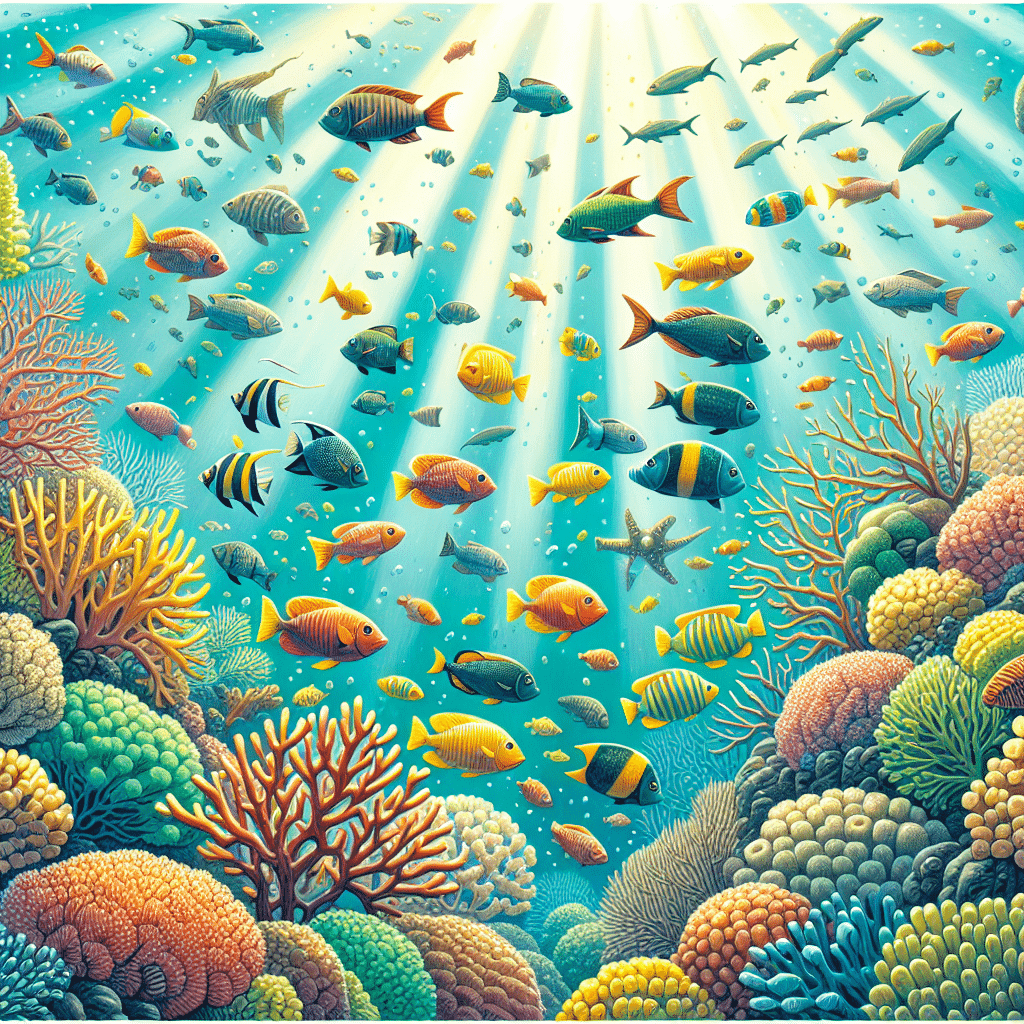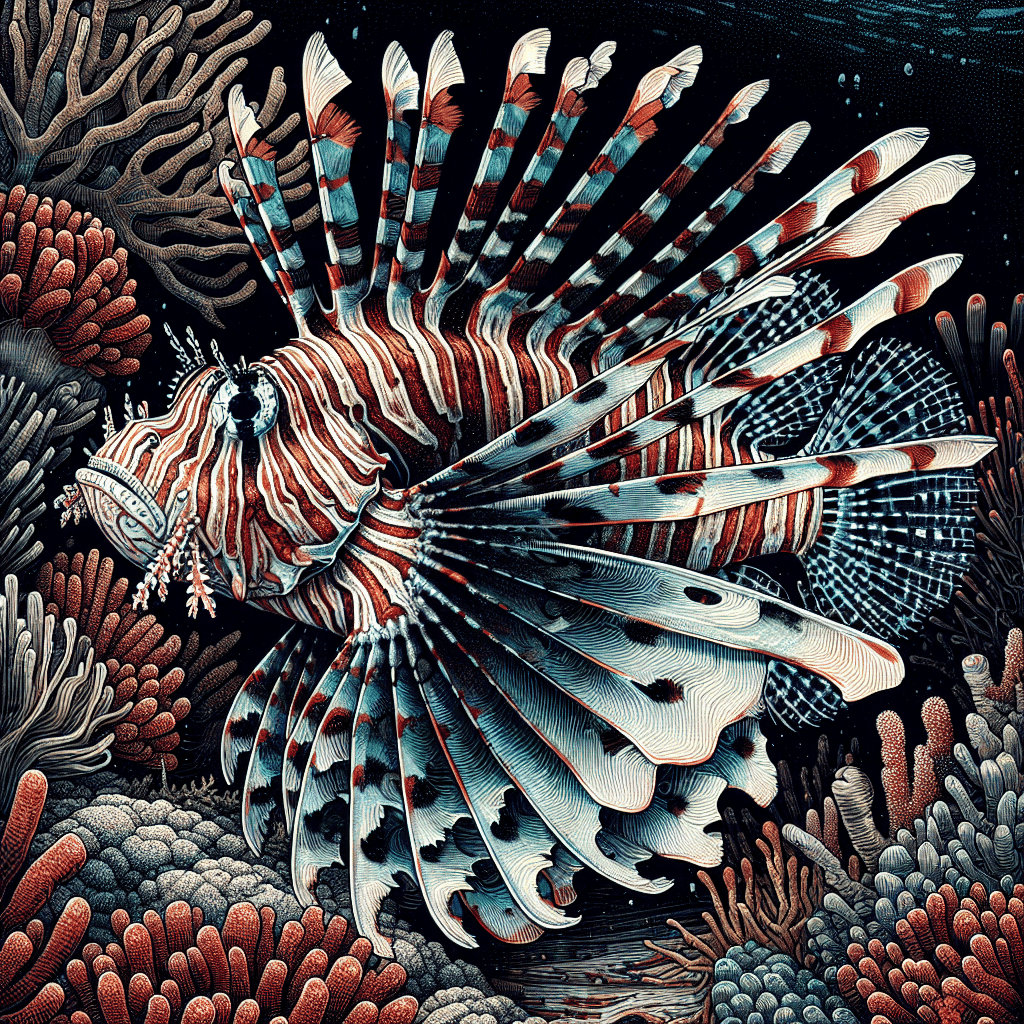Banggai Cardinalfish Overview
The Banggai cardinalfish, scientifically known as Pterapogon kauderni, is a stunning addition to any reef tank. I find their unique characteristics and behavior fascinating, making them a great choice for hobbyists like me.
Habitat and Behavior
The Banggai cardinalfish is endemic to the Banggai Islands in Indonesia. It thrives in shallow waters at depths between 1.5 to 5 meters, often found around jetties and over sandy bottoms with sea grasses. These fish are known to hide among the spines of sea urchins for protection against predators, showcasing their clever behavior in the wild. Their preference for calm waters, although they can tolerate areas with larger currents, makes them a bit particular about their habitat.
Physical Characteristics
One of the most striking features of the Banggai cardinalfish is its appearance. They reach about 3 inches in total length and are easily recognizable by their tasseled first dorsal fin and long tapering second dorsal fin. Their body is predominantly gray, adorned with bright silver flecks and bold black vertical stripes, making them a visually stunning specimen (National Aquarium).
| Feature | Description |
|---|---|
| Scientific Name | Pterapogon kauderni |
| Maximum Length | 3 inches |
| Coloration | Gray body with silver flecks and black vertical stripes |
| Dorsal Fin | Tasseled first dorsal fin, long tapering second dorsal fin |
| Habitat Depth | 1.5 – 5 meters |
These characteristics not only make the Banggai cardinalfish a beautiful addition to my tank but also a hardy and disease-resistant species, which is perfect for those of us who might be new to keeping marine fish. For more information on other marine fish options, explore our section on marine fish.
Conservation Status and Threats
Human Impact
The Banggai cardinalfish has become increasingly popular in the aquarium trade since its introduction in the 1990s. Unfortunately, this popularity has led to significant over-collection and exploitation, putting the species at risk of extinction. With a restricted range and a shallow habitat confined to the Banggai Islands of Indonesia, the total population is estimated to be around 2.4 million, but this number is declining due to human activities (National Aquarium).
One of the greatest threats to the Banggai cardinalfish is the capture of significant numbers from the wild for home aquariums. Human activity has not only led to a reduction in their population but has also impacted their natural habitat. Coral reefs, where these fish thrive, are being destroyed through harmful practices like fish bombing and the use of cyanide to catch live fish for the ornamental trade. As a result, the Banggai cardinalfish is classified as an endangered species, facing dire consequences from both overfishing and environmental degradation.
Threats to Survival
The survival of the Banggai cardinalfish is threatened by both natural and anthropogenic factors. While human impact plays a large role, these fish also face predation, especially as juveniles. Young Banggai cardinalfish are often preyed upon by natural predators, including those that inhabit the same coral reef environments. Additionally, their habitat is at risk due to increased agricultural runoff and human population growth, which leads to elevated waste and nutrient levels in marine ecosystems.
The combination of limited geographic range—approximately 5,500 km²—and concentrated populations around a few islands exacerbates the risk of extinction. This isolation makes it challenging for the species to recover from population declines. Furthermore, diseases like iridovirus pose additional threats, causing mortality in captured individuals and those in the wild.
Here’s a quick summary of the threats facing the Banggai cardinalfish:
| Threat Type | Impact |
|---|---|
| Over-collection | Decreased wild populations |
| Habitat destruction | Loss of coral reef ecosystems |
| Natural predation | Increased mortality in juveniles |
| Environmental degradation | Elevated waste and nitrates in water |
Understanding these threats is crucial for anyone interested in keeping the Banggai cardinalfish in their own aquariums. Promoting sustainable practices can help ensure that this beautiful species continues to thrive, both in the wild and in our homes. For more information on other marine fish, check out our articles on clownfish and tang.
Banggai Cardinalfish in the Wild
Feeding Habits
The Banggai cardinalfish is a carnivore, primarily feeding on plankton and small, bottom-dwelling crustaceans. They thrive on a diet rich in copepods, but they also enjoy other planktonic organisms when they are abundant in their habitat. These fish typically inhabit shallow, calm waters among coral reefs and seagrass beds of the Banggai Archipelago in Indonesia (NOAA Fisheries).
In the wild, their diet consists of:
| Food Source | Description |
|---|---|
| Copepods | Small crustaceans |
| Plankton | Various small marine organisms |
| Benthic Crustaceans | Bottom-dwelling crustaceans |
| Small Fish | Other small fish species |
| Mobile Invertebrates | Various invertebrates |
When keeping Banggai cardinalfish in aquariums, it’s crucial to provide them with meaty foods such as feeder shrimps, marine flesh, and bloodworms. They do not adapt well to dry prepared foods like pellets and flakes.
Reproduction Process
Banggai cardinalfish have a unique reproductive strategy as they are paternal mouthbrooders. This means that after mating, the male carries the fertilized eggs in his mouth for protection. This incubation period lasts anywhere from 23 to 30 days, and during this time, the male may release anywhere from 10 to 20 fry at once (Nano-Reef.com).
Here are some notable points about their reproduction:
| Aspect | Details |
|---|---|
| Mating Behavior | Non-monogamous pairs; females mate with multiple males |
| Incubation Period | 23-30 days |
| Fry Released | 10-20 fry at a time |
| Territorial Behavior | Females become more protective after mating |
The Banggai cardinalfish lacks a planktonic stage in its life cycle, which contributes to its vulnerability in the wild. In captivity, they have a short lifespan of around 4 years, while in the wild, they typically live for 1 to 2 years. Understanding their feeding habits and reproduction process is essential for those of us interested in keeping these fascinating fish in our home aquariums.
Banggai Cardinalfish in the Aquarium Trade
Popularity in Home Aquariums
I’ve always found the Banggai cardinalfish to be a captivating addition to any reef tank. These vibrant little fish were introduced into the pet trade in the 1990s and quickly became a favorite among hobbyists. Their striking appearance and relatively hardy nature make them an excellent choice for home aquariums. However, their restricted range and shallow habitat in the Banggai Archipelago of Central Sulawesi, Indonesia, put them at risk of over-collection and exploitation (National Aquarium).
In my experience, having a Banggai cardinalfish in my tank not only adds a splash of color but also brings a unique dynamic to the aquarium. They are known for their peaceful temperament, making them compatible with many other species. However, it’s crucial to remember that their popularity has led to significant collection pressures in the wild.
| Feature | Description |
|---|---|
| Scientific Name | Pterapogon kauderni |
| Habitat | Banggai Archipelago, Central Sulawesi, Indonesia |
| Temperament | Peaceful |
| Size | Up to 3 inches |
Captive Breeding Success
Fortunately, the Banggai cardinalfish has been successfully bred in captivity, providing a sustainable alternative to wild-caught specimens. This method of breeding is essential, especially considering that the species is listed as endangered by the IUCN due to extensive collection for the aquarium trade. As a fish tank enthusiast, I appreciate the efforts being made to ensure these beautiful fish can thrive without the risk of over-exploitation.
Captive breeding programs have shown that the Banggai cardinalfish is relatively easy to raise, making it a viable option for aquarists looking to contribute to conservation efforts. The New Jersey State Aquarium has had success with their breeding program, and organizations like LINI are working on marine conservation initiatives in the Banggai Archipelago (Lamar University).
By choosing captive-bred Banggai cardinalfish, we can help reduce the pressure on wild populations while still enjoying these stunning fish in our aquariums. For more information on care and feeding, check out our guides on marine fish and specific species like clownfish and tang.
Care and Feeding Guidelines
Taking care of Banggai Cardinalfish can be a rewarding experience, especially when it comes to their feeding and breeding. Here’s what I’ve learned about their diet recommendations and some breeding tips to ensure they thrive in my aquarium.
Diet Recommendations
Banggai Cardinalfish are carnivorous, which means they require a diet rich in meaty foods. In the wild, they feed on benthic crustaceans, zoobenthos, small fish, and mobile invertebrates. For my aquarium, I make sure to provide them with high-quality foods that mimic their natural diet. Here are some key feeding options:
| Food Type | Description |
|---|---|
| Feeder Shrimp | A great source of protein; they love it. |
| Marine Flesh | Provides essential nutrients. |
| Bloodworms | A tasty treat that can be offered regularly. |
| Artemia Nauplii | Ideal for fry; they can be weaned onto this. |
It’s important to note that they cannot consume dry prepared foods like pellets or flakes (Lamar University). Therefore, I focus on offering fresh or frozen options to keep them healthy and active.
Breeding Tips
Breeding Banggai Cardinalfish can be an exciting venture. From my experience, there are a few essential practices to follow for successful breeding:
Feeding Fry: Once the fry are released, I ensure they have access to Artemia nauplii (baby brine shrimp) immediately. This provides them the necessary nutrition they need to grow. After a few weeks, I start weaning them onto frozen foods like spirulina brine shrimp or products like Reef Nutrition TDO (Nano-Reef.com).
Frequent Feeding: For the first two weeks, I feed the fry every 3 hours during the day. This frequent feeding helps them grow and thrive.
Breeding Process: The male Banggai Cardinalfish carries the eggs for about 23-30 days before releasing the fry. I’ve noticed that they tend to release their fry in the early morning or right after the lights go off. It’s fascinating to observe how the fry seek shelter among sea urchins, which makes it easier for me to collect them.
Pair Formation: Banggai Cardinalfish often form non-monogamous pairs, with females willing to mate with multiple males. As the male holds the eggs, the female becomes more territorial, which is something I’ve seen in my tank.
By following these care and feeding guidelines, I’ve been able to successfully maintain my Banggai Cardinalfish and even breed them in my home aquarium. If you’re interested in more about marine fish in general, check out our articles on marine fish and other fascinating species like clownfish and lionfish.
Conservation Efforts
Breeding Programs
The conservation of the Banggai cardinalfish has become increasingly important due to its popularity in the aquarium trade. Over the years, I’ve discovered that breeding programs have been established to help protect this unique species. One significant initiative began at the New Jersey State Aquarium. This program aims to breed the fish in captivity, reducing the pressure on wild populations.
In 2010, the LINI organization started working in the Banggai Archipelago, Central Sulawesi, Indonesia, to assist in developing a marine conservation program for the area (Lamar University). This initiative focuses on breeding the cardinalfish while educating local communities about sustainable practices.
The Banggai cardinalfish was listed as endangered in 2007 due to the high demand in the aquarium trade, which saw around 900,000 individuals caught annually. Breeding programs play a vital role in restoring wild populations and ensuring the species’ long-term survival.
Marine Protected Areas
Another crucial aspect of conservation efforts involves establishing marine protected areas (MPAs). These zones are designated to protect the natural environment and the species that inhabit it. A project conducted from April 2008 to April 2011 in Indonesia focused on understanding the importance of MPAs and their impact on the Banggai cardinalfish.
Marine protected areas help to reduce fishing pressure and habitat destruction, allowing fish populations to recover. They also support the local economy by promoting sustainable fishing and ecotourism, which can provide alternative livelihoods for communities that rely on the ocean for their income.
The global ornamental fish trade is a massive industry, involving approximately 55 million organisms sold annually for aquariums, with a retail value of around US$2.15 billion. The Coral Triangle, which includes Indonesia, is a significant region for this trade, emphasizing the need for better management and data to ensure sustainability (Dialogue Earth). By creating marine protected areas, we can help balance conservation with the economic needs of local communities, ensuring a brighter future for the Banggai cardinalfish and its habitat.
Importance of Sustainable Practices
Impact of Fishing
Fishing practices have a significant effect on the Banggai cardinalfish population. Approximately 900,000 individuals are caught annually for the aquarium trade, which led to the species being listed as endangered by the IUCN in 2007 (Dialogue Earth). The global ornamental fish trade involves around 55 million organisms sold each year, with a retail value of about $2.15 billion. This high demand has prompted overfishing, particularly in the Coral Triangle region, which includes Indonesia, where these fish are primarily sourced.
To mitigate the depletion of Banggai cardinalfish, there have been efforts to curb wild catching and promote sustainable practices in the aquarium trade. For instance, fishing for these fish has shifted to areas introduced by humans, like Manado and Bali, where fish that failed export screening were released into the wild. In 2024, Indonesia’s National Research and Innovation Agency set a quota of 38,000 Banggai cardinalfish for capture, aiming to better manage this resource.
| Year | Quota (Individuals) |
|---|---|
| 2024 | 38,000 |
Economic Considerations
The Banggai cardinalfish has become a must-have for aquariums since the 1990s, which has fueled its demand. This popularity has provided livelihoods for many in regions where the fish are harvested, but it also raises concerns about the long-term sustainability of the practice.
Sustainable fishing and breeding practices are essential not only for the survival of the Banggai cardinalfish but also for the economic stability of communities relying on this trade. By ensuring that the fishing is regulated and that breeding programs are supported, we can maintain both the fish population and the economic benefits that come from responsible harvesting.
Adopting sustainable practices helps to balance the needs of the aquarium trade with the health of marine ecosystems. This approach not only protects species like the Banggai cardinalfish but also supports the economies of the communities that depend on them. For those interested in marine fish, understanding the implications of these practices is vital for making informed decisions in their own aquarium setups.
Future of the Banggai Cardinalfish
Protection Measures
The Banggai cardinalfish has faced significant pressures from the aquarium trade, leading to its designation as endangered in 2007 by the IUCN. Approximately 900,000 individuals are caught annually for this trade, prompting the need for strict protection measures to help curb wild capture. In 2024, Indonesia’s National Research and Innovation Agency (BRIN) set a quota of 38,000 Banggai cardinalfish to be harvested, with specific allocations for different regions, including Bali and Central Sulawesi. This is a step towards sustainable management of the species.
Sustainable Management
Sustainable management practices are crucial to ensure the long-term survival of the Banggai cardinalfish. The global ornamental fish trade is immense, with around 55 million organisms sold annually, valued at approximately $2.15 billion. The Coral Triangle, which encompasses Indonesia, is a vital area for this trade, supporting local livelihoods. However, better management and data collection are needed to balance economic benefits with ecological health (Dialogue Earth).
Additionally, the Banggai cardinalfish plays an important role in the marine ecosystem. It serves as a food source for various species, including lionfish, grouper, and moray eels. Protecting this species not only aids its population but also supports the larger marine food web.
As I engage in this hobby, I understand the importance of sustainable practices in our aquariums and the broader environment. By supporting responsible sourcing and captive breeding programs, we can help ensure the future of the Banggai cardinalfish and similar species.



